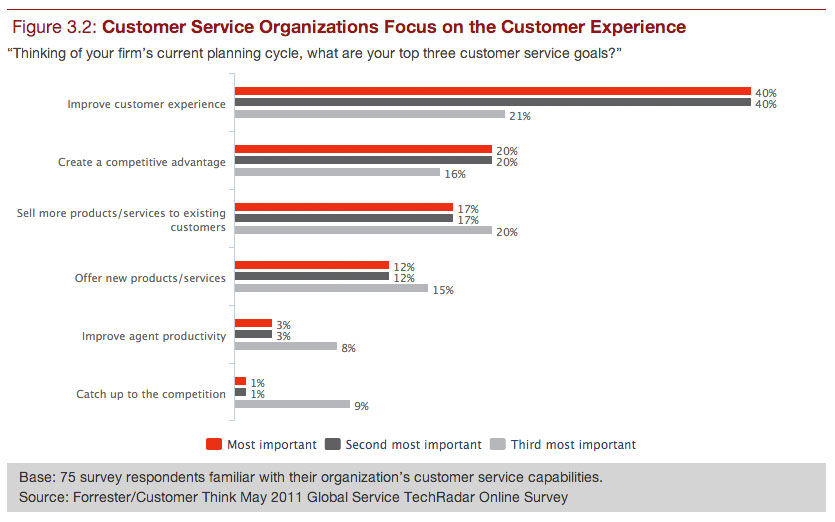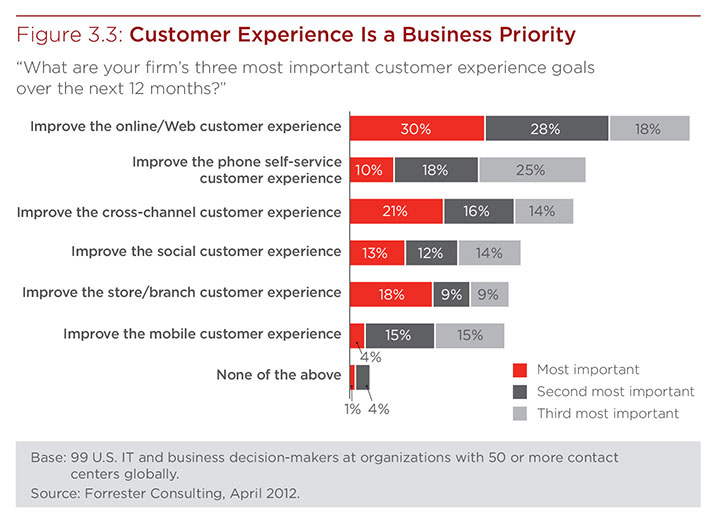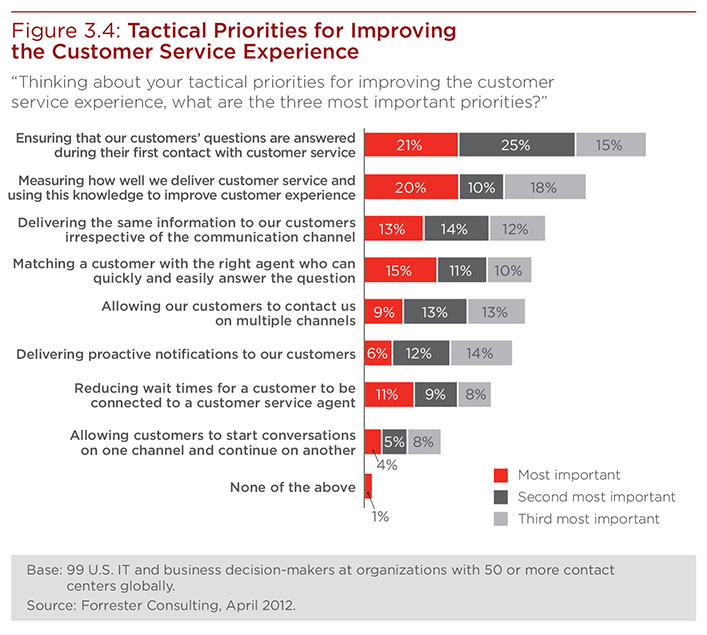Today, the gap between a customer’s expectations and the service they receive is huge. Customers are increasingly knowledgeable about the products they use, and they demand value-added, personalized service in real time, using voice, text-based media like email and chat, and social media. If they have a poor customer experience, they are quick to voice their disappointment, which is amplified by social media and can lead to brand erosion.
Source: Forrester/Customer Think May 2011 Global Service TechRadar Online Survey
Businesses know that good service is important—90 percent of customer service decision-makers tell Forrester that delivering good service is critical to their company’s success; 63 percent think its importance has risen. Yet, businesses today are battling ongoing economic pressures resulting from a prolonged global recession. Most companies are primarily focused on cost control measures and struggle to offer a service experience that differentiates their brand in a world of commoditized products and services.
Businesses must be pragmatic about engaging in initiatives that will deliver service in line with customer expectations, yet at a cost that makes sense to the business. One successful way to help move the needle on an improved customer service experience—in a way that is cognizant of business cost parameters—is by focusing on the contact center and collaboration technologies that customer service organizations use. They allow you to standardize the customer experience across supported media types: voice, text-based interactions, and social media.
These technologies provide agents with a unified desktop where they can simultaneously handle multiple interactions. They enable agents to collaborate with one another, with subject matter experts, and with their managers, allowing them to quickly solve customer inquiries—making agents more efficient and empowering them to deliver a higher quality of interaction. They provide managers with the flexibility to develop new routing scripts, to access real-time reports and analytics, and to collaborate with senior management to quickly adapt to changing business demands. In addition, improved contact center and collaboration technologies deliver an overall lower cost of ownership. Businesses that fail to focus on their core contact center and collaboration technologies risk being left at a competitive disadvantage.
Source: Forrester Consulting, April 2012.
Delivering the Right Customer Experience Is Important but Hard to Do
Because of economic pressures and the commoditization of products and services, businesses turn to the customer service experience as a differentiator. In fact, data from a recent survey shows that focusing on an improved customer experience is currently one of the most important goals of customer service organizations: 40 percent of respondents identified it as their top goal, 40 percent identified it as their second most important goal, and another 21 percent identified it as their third most important goal. (See Figure 3.2.)
When asked what a company’s three most important customer experience goals were, 30 percent of IT and business decision-makers surveyed stated that improving the online/Web experience of customers is their most important goal; 18 percent said that improving the phone experience is their second most important goal; and 14 percent said that improving their cross-channel experience is their third most important goal. (See Figure 3.3.)
Few Companies Deliver a Successful Customer Experience
Even though businesses know that they can reap quantifiable business results by focusing on the customer service experience, few businesses deliver good service. In 2012, Forrester reported that only 37 percent of companies earned an “excellent” or “good” Customer Experience Index rating—an index that measures the ease, usefulness, and enjoyment of doing business with a company. Almost two-thirds of brands were rated as delivering an “OK” to “very poor” customer experience. Banks, credit card providers, Internet service providers, and health insurance companies surveyed had the biggest gap between their top scores and lowest scores, which points to the quantifiable business opportunities in this segment.
Customer Service Organizations Struggle to Provide Service That Meets Expectations
It’s evident that delivering good service is hard to do. Today’s world is increasingly complex. Customer service organizations need to assist customers with more and more complicated products and services and are forced to do so with limited resources. As a result, first contact resolutions and satisfaction metrics decrease.
Specifically, customer service decision-makers struggle to:
Support the breadth of media types. Customers want to use an increasing number of media types when receiving customer service. In the past 12 months, 68 percent used the phone, 60 percent used help or FAQs, 54 percent used email, 37 percent used chat, 20 percent used SMS or text messaging, and 19 percent used a microblogging platform. Customer service agents supporting these media types need access to the same data and information to ensure a consistent service experience.
Empower agents with a full view of customer interactions. Customers expect consistent, value-added answers across all media types. They also want to start an interaction using one media type and be able to complete it on another without having to restart the conversation. However, only 21 percent of organizations are planning to integrate their communications channels to provide this seamless experience. This means that these communication channels and the agents supporting them are siloed from one another. Agents do not have a full view of prior customer interactions across all supported media types, so they can’t personalize and contextualize an answer to a customer request.
Communicate contextual answers to customers. Customer service agents do not have access to full customer data, product data, or records of prior interactions. They also must use a number of disconnected applications when servicing their customers, and they struggle to find the right and relevant answer to a customer’s request.
Allow customer service agents and leaders to collaborate. Customer service agents are disconnected from the best resources, such as specialized agents and subject matter experts, that can quickly help answer a customer request. This leads to unnecessary escalations and callbacks, which increase handle times and erode customer satisfaction. Customer service supervisors and managers are disconnected from their leaders and the CIO, making it difficult to develop better systems integration to increase the efficiency of their agents. Customer service leaders cannot make operational changes quickly to react to changing business needs.
Choose the right metrics to measure their performance. Many contact centers focus on productivity measures, such as average speed of answer and handle times, to gauge the success of their operations, and they focus less on how effectively their agents resolved a customer’s inquiry. This can lead managers to reward agents for wrong behavior that erodes customer satisfaction. It’s no wonder that in a Forrester survey commissioned by Avaya, when asked what tactical priorities organizations have for improving the customer service experience, 61 percent of respondents said that they want to ensure that their customer’s questions are answered upon first contact resolution, 48 percent of respondents said that they want to be able to measure how well they deliver customer service, 39 percent said that they want to ensure that they are delivering the same information across all communication channels used, and 36 percent said that they want to focus on matching the customer with the right agent, which includes collaboration between agents who can quickly answer a customer’s question. (See Figure 3.4.)
Source: Forrester Consulting, April 2012.
Four Steps to a Better Customer Experience
Delivering optimal customer experience is a multiyear modernization and transformation project that takes a coordinated effort across four dimensions: strategy, processes, technology, and people management.
Start by articulating your customer experience strategy. Your customer experience strategy identifies the customers your organization intends to serve and articulates the customer experience you want to deliver across all media types and all company touchpoints that are in line with your brand proposition.
Focus on the right processes for your customers. Processes that customer-facing personnel follow to service customers have to be consistent across all media types supported, effective in meeting customer requirements, and agile so they can be changed to support a business’s changing needs.
Choose technologies that empower your customer service organization to deliver excellent experiences. Contact center and collaboration technologies are at the heart of the solution for providing optimal customer experiences. Contact center technology must be able to standardize the customer service experience across media types, including social media; empower agents with contextual customer, product, and service information; and provide managers with the right analytics to track outcomes that have a business impact. Collaboration technology must allow agents to collaborate with subject matter experts to resolve inquiries quickly; must allow internal collaboration between agents, managers, and IT to develop better integration of systems; and must allow collaboration at the C level to understand customer needs and adjust the business accordingly.
Don’t forget about your people. Organization and leadership are important factors that affect customer service success and make up your organization’s corporate culture, leadership practices, collaboration methods, training programs, and performance measurement approaches. It’s also important to empower your agents to do the right thing for the customer. They are, after all, your most important asset.
Improving the Customer Experience Is Good for Business
Forrester reports that a good customer experience correlates to loyalty, as well as increased lifetime customer wallet share size, as measured in three classic categories: willingness to consider the company for another purchase, likelihood to switch business to a competitor, and likelihood to recommend to a friend or colleague.
This direct correlation between a good customer experience and positive business value is evident in more than 40 industries that Forrester surveyed. Improving the customer experience is also good for internal operations. Companies that have invested in delivering better customer experiences report greater ability to collaborate internally, reduced operational costs, greater productivity of their front-line personnel, and greater business agility—necessary requirements to stay ahead of your competition.
To take advantage of the real business value of good customer experiences, assess your current contact center operations and develop a stepwise execution plan that includes a clear focus on strategy, processes, technology, and people.


